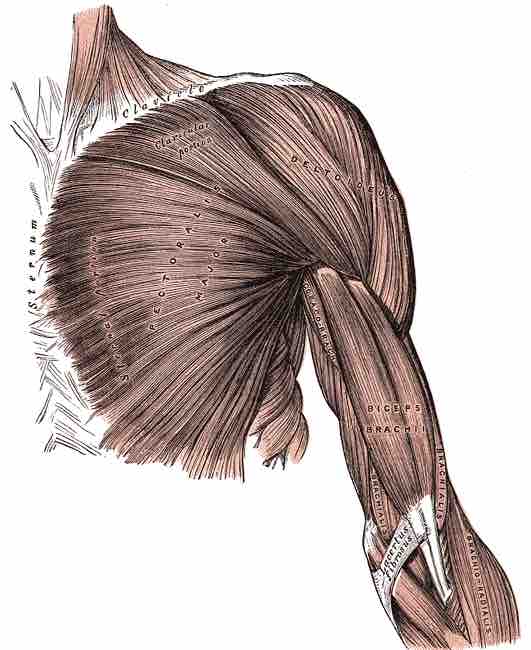The humerus is a long bone in the arm that runs from the shoulder to the elbow. Anatomically, it interacts with the scapula to form the shoulder joint and the radius and ulna of the lower arm to form the elbow joint. Forearm rotation is controlled by two joints: the proximal radioulnar joint which exists immediately below the elbow, and the distal radioulnar joint located immediately before the wrist.
Upper Arm
There are four muscles in the upper arm split into an anterior and posterior compartment.
Anterior Compartment
Three muscles are located in the anterior compartment of the upper arm.
Biceps Brachii - The biceps brachii is a two-headed muscle. Although the majority of the muscle mass is located anteriorly to the humerus, it has no attachment to the bone itself.
- Attachments - Both heads originate from the scapula and attach via the bicipital aponeurosis to the fascia of the forearm.
- Action - Supination of the forearm. It also flexes the arm at the elbow and at the shoulder.
Coracobrachialis - The coracobrachialis lies within the two heads of the biceps brachii.
- Attachments - Originates from the scapula and attaches to the humerus.
- Action - Flexing of the arm at the shoulder, and weak adduction.
Brachialis - The brachialis muscle lies within the distal region of the biceps brachii.
- Attachments - Originates from the humerus and attaches to the ulna.
- Action - Flexing of the arm at the elbow.
Posterior Compartment
The posterior compartment of the upper arm contains only one muscle.
Triceps Brachii - The triceps brachii is a three-headed muscle.
- Attachments - The long head originates from the scapula, the lateral head from the proximal region of the humerus, and the medial head from the distal region of the humerus. All three converge into one tendon which attaches to the ulna.
- Action - Extension of the arm at the elbow.

Superficial muscles of the chest and upper arm
The biceps brachii is located in the anterior compartment of the upper arm and flexes and supinates the forearm at the elbow.
Forearm
As with the upper arm, the forearm is split into anterior and posterior compartments. Only those responsible for movement of the forearm are discussed below; the muscles responsible for movement of the hand and wrist are discussed in a later section.
Anterior
The anterior compartment of the forearm is split into superficial, intermediate, and deep regions.
Pronator Teres - A rectangular muscle located in the superficial region of the anterior compartment.
- Attachments - The pronator teres has two origins, one on the proximal end of the humerus and one of the distal end of the ulna. It attaches to the mid region of the radius.
- Action - Pronates the forearm.
Pronator Quadratus - A square shaped muscle located adjacent to the wrist in the deep region of the anterior compartment.
- Attachments - Originates from the ulna and attaches to the radius.
- Action - Pronates the forearm.
Posterior
The posterior compartment of the forearm is split into superficial and deep regions.
Anconeus - The anconeus is located in the superficial region of the forearm posterior compartment and is blended with the triceps brachii.
- Attachments - Originates from the humerus and attaches to the ulna.
- Action - Moves the ulna during pronation and extends the forearm at the elbow.
Brachioradialis - The brachioradialis is located in the superficial region of the forearm posterior compartment,
- Attachments - Originates from the humerus and attaches to the distal end of the radius.
- Action - Flexes the forearm at the elbow.
Supinator - The supinator is located in the deep region of the forearm posterior compartment.
- Attachments - The supinator has two heads: one originating from the humerus, the other from the ulna. Together they attach to the radius.
- Action - Supinates the forearm.

Superficial muscles of the posterior forearm
The anconeus, located in the superficial region of the posterior forearm compartment, moves the ulna during pronation and extends the forearm at the elbow.
Key Movements
Extension (forearm away from upper arm)
- Produced by the triceps brachii and anconeus of the forearm.
Flexion (forearm towards upper arm)
- Produced by the brachialis, biceps brachii, and brachioradialis of the forearm.
Pronation (rotation of the forearm so the palm faces downwards)
- Produced by the pronator quadratus and pronator teres of the forearm.
Supination (rotation of the forearm so the palm faces upwards)
- Produced by the supinator of the forearm and biceps brachii.